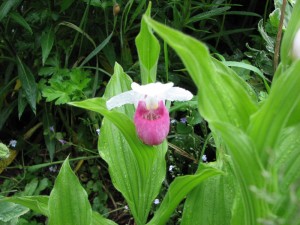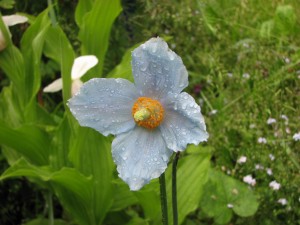No Green Thumbs!
I’ve been accused of having a green thumb. I don’t. But I can understand why someone might think so. I have lots of successful flowers, shrubs, trees and vegetables growing on my property every year. But I’m willing to bet that I’ve killed more plants than that guy who claims to have a “brown thumb”. I take chances, buying and trying perennials that are outside their normal climatic zone. I try plants that are persnickety, and then try them again after I kill the first ones.
The late author and illustrator Tasha Tudor, a great gardener who lived in southern Vermont, told me once that she buys at least three pots of any new perennial, and then tries them out in different places on her property to see where they do the best. Often she would buy seven or more pots of the same plant. She tried them in places that had more sun, or less. More natural moisture or less. Like me, I bet she tried different amounts of soil additives for the same kind of plant – more compost, more peat moss or limestone, or more sand, for example.
So what makes a successful gardener? Getting the right soil for each plant. Soil is the key to gardening success. This is a good time, in mid-winter, to pause and learn about soils and to think what you might do, come spring.
There are three basic types of soil; sandy soil, loam and heavy clay soils. Most plants prefer, according to the gardening literature, “Moist, rich, well drained soil.” So how do you get that? It takes time and effort.
The soil most plants want has a mixture of particle sizes: small (clay), medium (loam) and large (sand). Very small particles pack together tightly and hold water with their electromagnetic charges. Clay soils do not drain well – they act like a bowl of baking flour. Sandy soils drain too well – like a wire basket full of golf balls. A good soil has some tiny particles, along with larger ones that provide good drainage.
If you have a clay soil, you cannot just add sand. Clay mixed with sand makes a soil that acts like like concrete. Similarly, if you have sandy soil that doesn’t easily hold water, you cannot just add lots of clay. The key ingredients for either soil are compost and other kinds of organic matter such as chopped leaves, peat moss or coir (coconut fiber). Adding compost is, in my opinion, always a good thing.
The great thing about compost is that it adds water-retention abilities (think of it as containing lots of little sponges) as well as living organisms that work well with your plants. But compost adds air spaces, too, so water can drain better in clay soils if you add lots of compost.
Plants thrive in soils that are biologically active: soils that are full of beneficial fungi, bacteria, protozoa. I read once that a teaspoon of healthy soil can contain 5 billion bacteria, 20 million filamentous fungi and a million protozoa. We tend to think of fungi and bacteria as bad: you may think of fungi as the mildews and molds on leaves. Our mothers told us often to wash our hands to keep bacteria out of our mouths. But in the soil there are many more good bacteria and fungi than bad ones.
Chemicals added to your lawn or garden may inhibit the growth and viability of those beneficial microorganisms. Most chemical fertilizers are composed of salts of nitrogen, phosphorus and potassium. Salts dry out living tissue and can easily kill microorganisms. Too much fertilizer can dry out and kill root hairs of your precious plants, too. Farmers talk of fertilizer “burning” the roots of young transplants. That means drying out the root hairs, killing them.
What else can you add to your soil to help it along? Here in the Northeast our rain is somewhat acidic, and that acid dissolves some minerals and washes them away. Plants need calcium and magnesium, both of which wash away in spring rains. You can buy a 50-pound bag of limestone and apply it in small quantities to your lawn and garden. If you get your soil tested, it should give a recommendation for how many pounds of limestone are needed for every hundred square feet of garden.
Please note: there are two kinds of limestone – dolmitic which contains magnesium, and calcitic, which does not. A soil test will tell you which kind to buy. Or, if you are on a budget and have a woodstove, you use wood ashes instead of limestone. Wood ashes are finer than limestone in a bag, so it is incorporated into the soil more quickly. Use wood ashes at the same rate as you would limestone that you purchased.
When the snow goes and the soil thaws, get a soil sample and send it off to your State Extension testing service. It can tell you what might be missing from your soil, the soil acidity, soil type and amount of organic matter. The more you know, the better your plants will grow!
Henry Homeyer is a gardening educator and lecturer with a specialty in organic gardening. His web site is www.Gardening-Guy.com.




